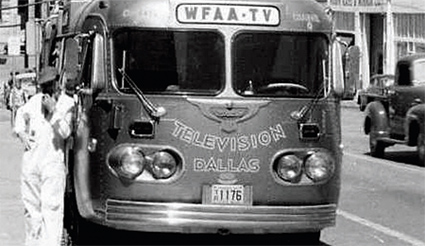To Drive or Not To Drive
“My boss is constantly saying to me: ‘Why do we keep buying ENG trucks?’” said Craig Harper, chief technical officer of Belo Corp., which has 20 TV stations. “Or he’ll say, ‘We’ll never buy another satellite truck again, will we?’ But we probably will.” Harper will find plenty of company out there who agree with him.

The DuMont Telecruiser, an early state-of-the-art news van, built for WFAA-TV’s predecessor, KBTV-TV in Dallas. Photo courtesy of Chuck Conrad. “We have reconciled the fact that we’re not going to get away from ENG vans totally,” said CBS Station Group vice president of engineering, Jeffrey Birch. CBS owns 28 stations in markets ranging from New York to Indianapolis. “There is no replacement for them.”
Jim Ocon is vice president for technology at Gray Television, which has 36 stations. He is not quite as bullish on trucks. “We have ENG vans that we’ll repair and keep them running, but we aren’t looking to purchase any new ones.”
RELIABILITY
All three station groups are experimenting with, and using day-to-day, alternative methods of transporting video back from the field. These include sending video files or live shots over cellular telephone networks and via Internet hot spots. But they express nervousness over the reliability of those technologies, and of relying on the third parties they introduce to the signal path.
It gets down to the mission-critical nature of getting live shots back to the studios for a station’s newscasts. “I own the satellite path, or I own that microwave path, so to speak,” Birch said. “If I use the cellphone boxes, I now rely on a third party to get from wherever I am to a point of presence, and then I rely on the Internet to get me from there back to my station. So there are a lot of links in the chain that I have no control over.”
Birch pays these new technologies a partial compliment: “When they work, they work great. We’ve done things with them that you never, ever thought you could do. Would I go to a presidential news conference with them? Not a prayer.”
Belo’s Harper expressed similar concerns. “We have a few systems like LiveU and others that we use, and they can work very, very well,” he said. “There’s always the challenge of, if you’re at a big event, and there are a lot of people with their cellphones on… and they’re sending pictures of the same event, it’s hard to get enough channels to make your picture work via video.”
The issue of latency, the technical word for delay, is also frequently raised when discussing delivering live video via 3G/4G cellular technology. A delay of something like 15 seconds, a number supplied by Birch, can wreak havoc with a live Q&A session between anchors in the studio and reporters in the field.
AVAST THE MAST
Ocon said that while Gray will look for smaller ENG vehicles, those smaller vehicles could still employ microwave technology, though not necessarily with the tall masts that were required for analog microwave.
“In New York City, where I have the most experience, we, in effect, don’t need the 42-foot mast anymore,” Birch said, “because digital microwave does bounce around a lot better than analog did, and they can get shots out of places we never used to be able to get out of. But if you’re going to take the truck outside of the city, if I need to do a shot from out on Long Island, or out in New Jersey somewhere, we still need the mast. And we go satellite too, we don’t just go microwave.”
Ocon said it’s a tough call, but “you and I only have so many dollars to spend in our ENG budget, so do you want to have all your eggs in one basket?” He noted that ENG van makers “have gotten smarter, turning out a little different kinds of vehicles that stations can use. The solution really depends on what the mission is as a broadcaster and news organization.”
Birch acknowledged “we’re looking at what we’re now able to do on a smaller and more efficient chassis, but it’s not going to be a wholesale replacement for the Ford 350 van.”
Get the TV Tech Newsletter
The professional video industry's #1 source for news, trends and product and tech information. Sign up below.
